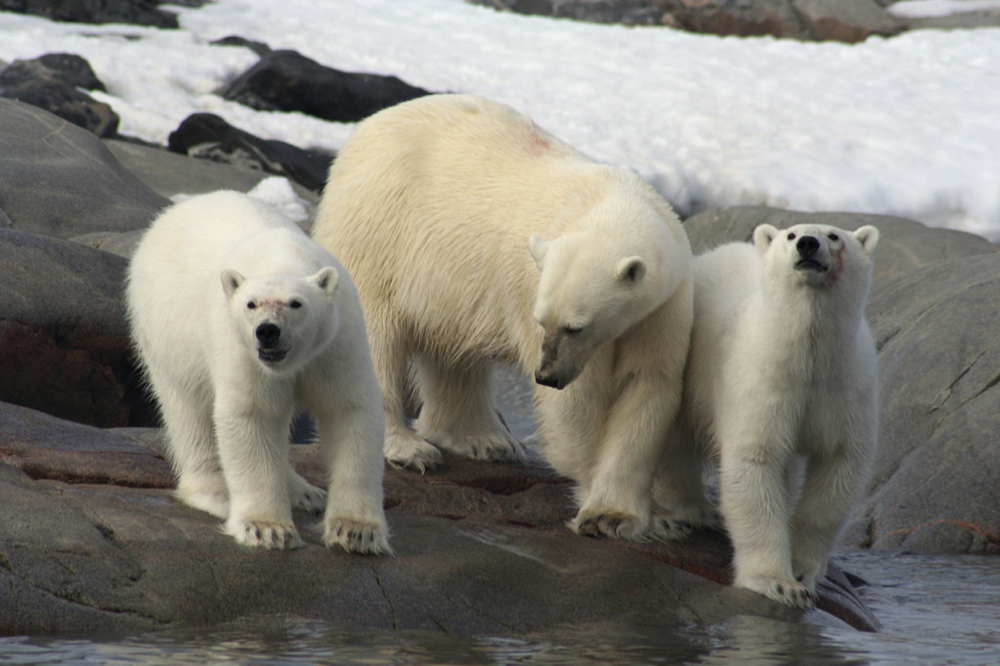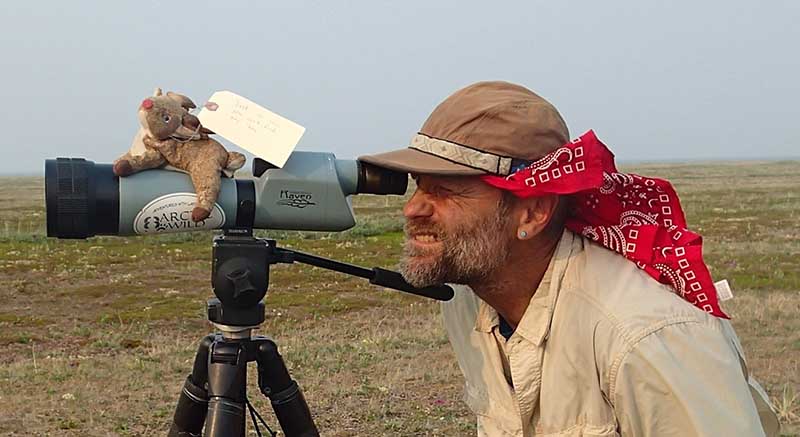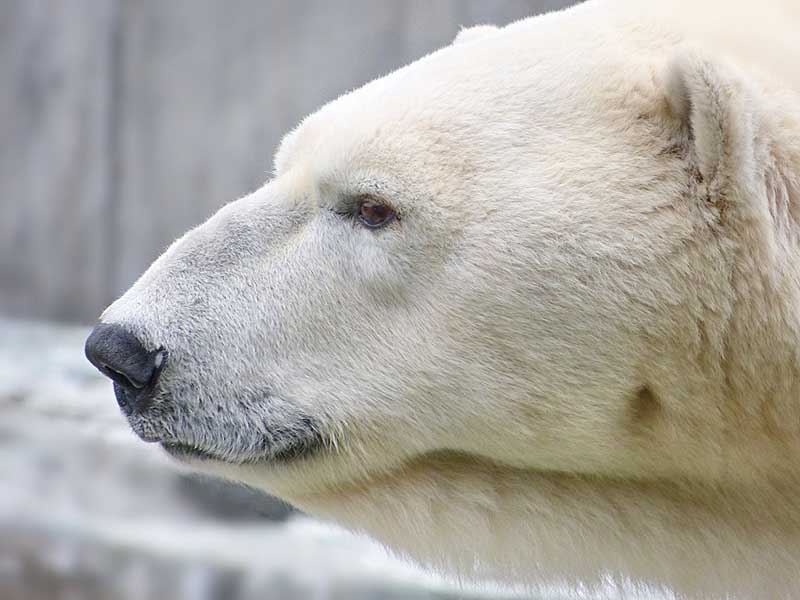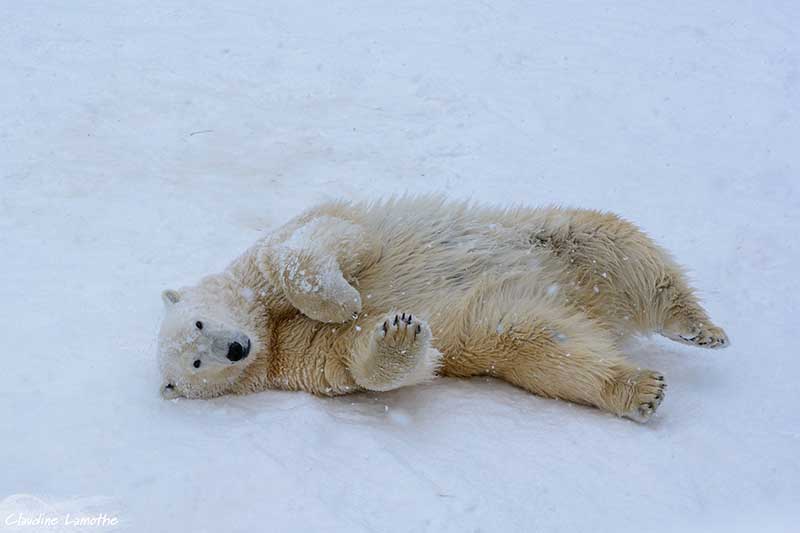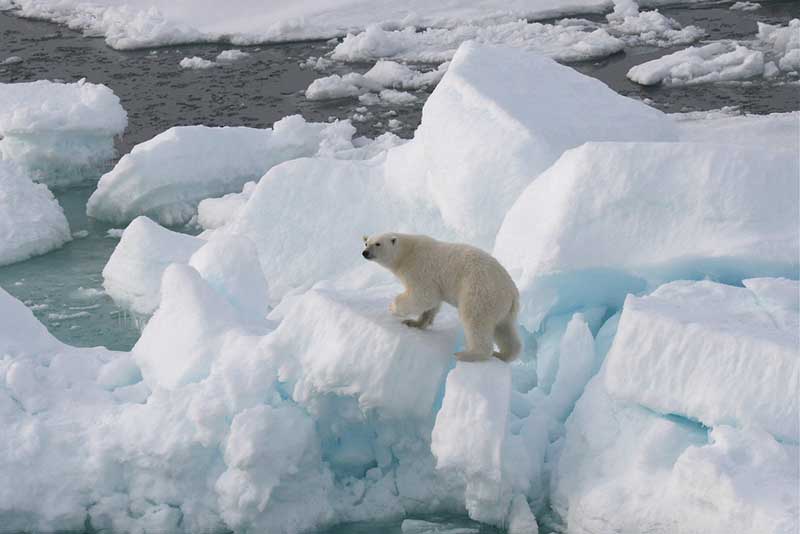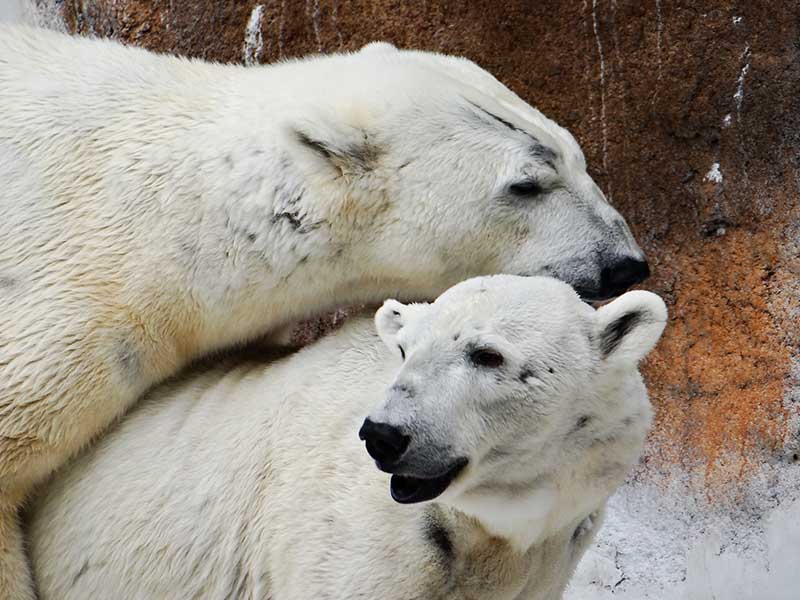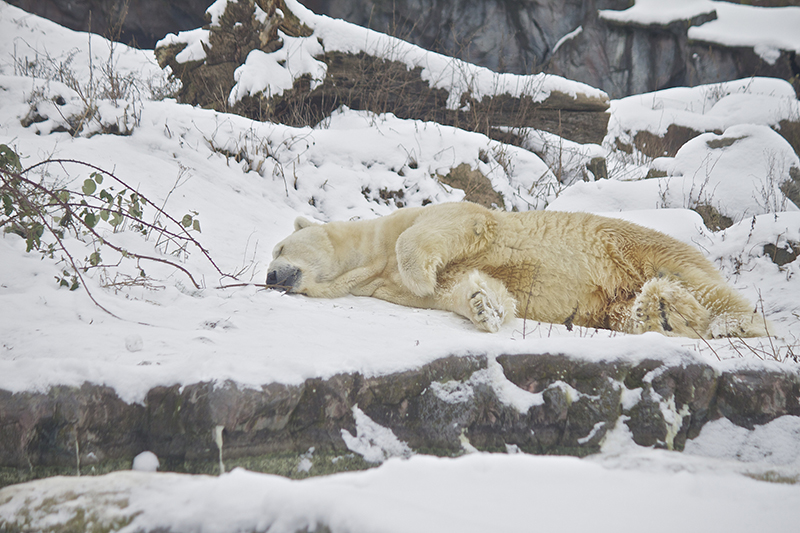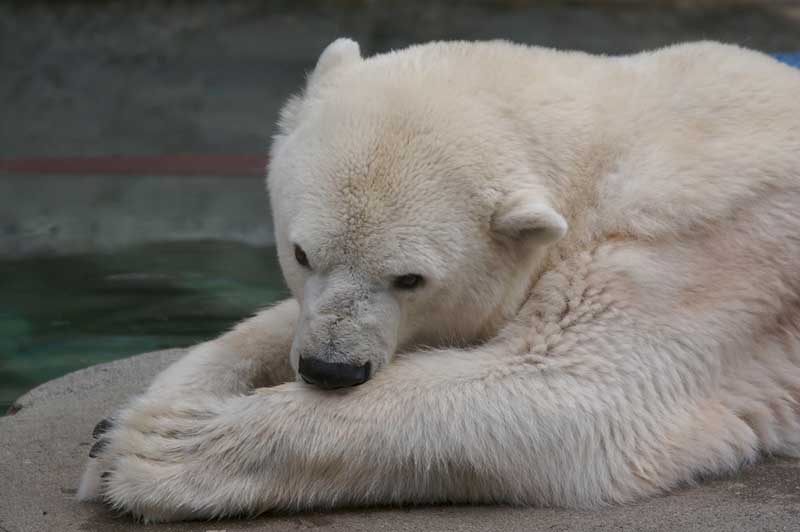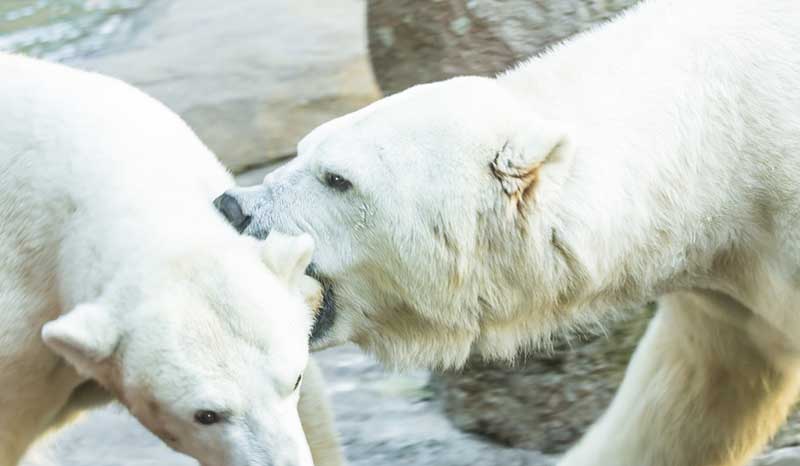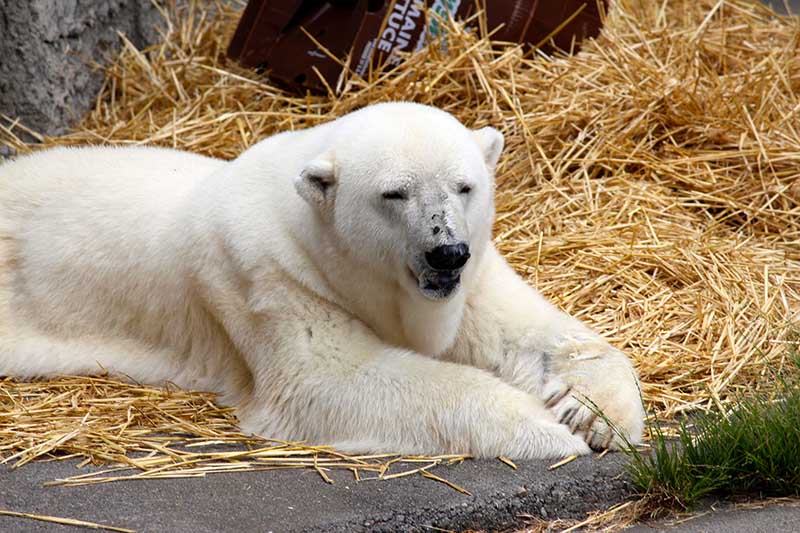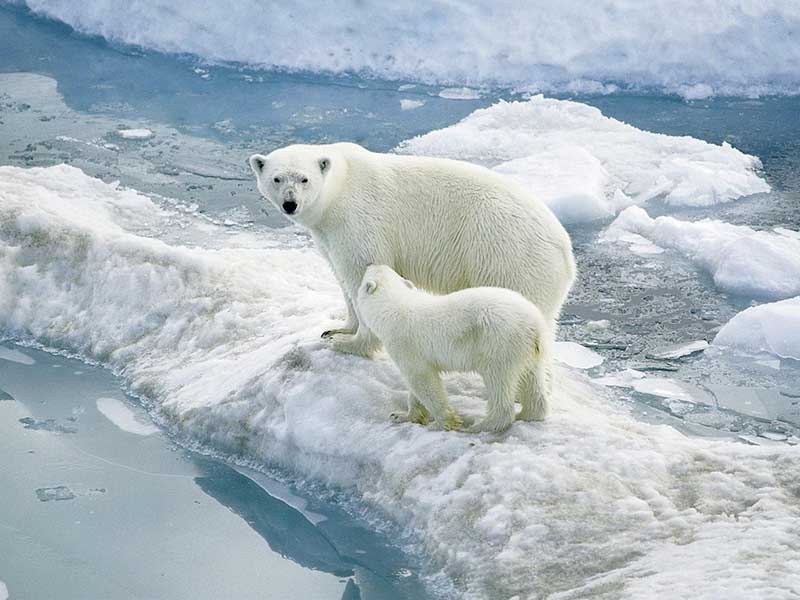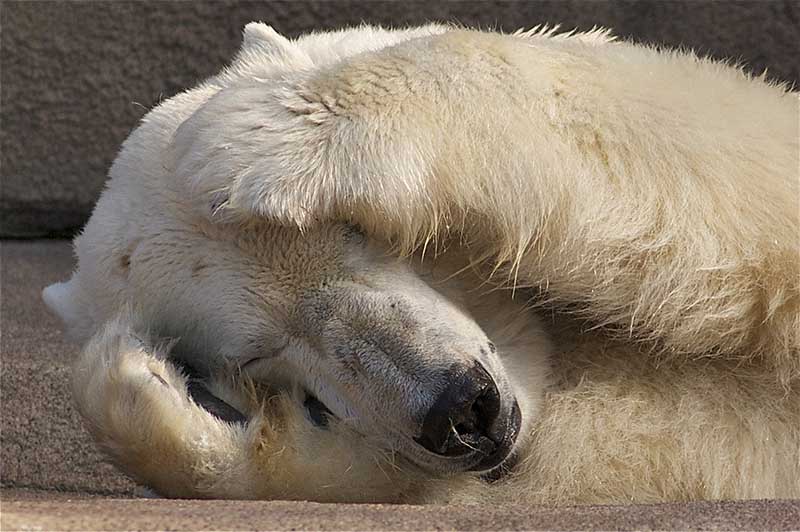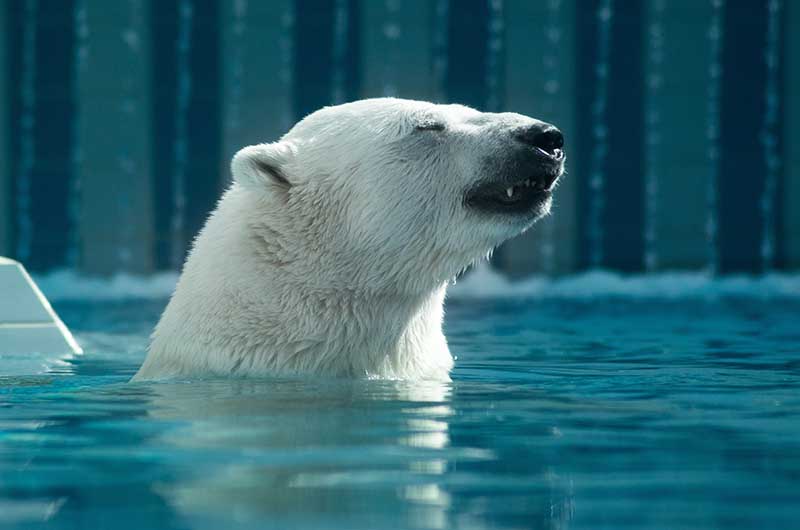BB: A bear “as big as a calf and as white as a swan” is the first description of a polar bear in his native environment that, as I learned from your book, dates back to Jacques Cartier’s exploration of Newfoundland in 1534. Mr. Engelhard, could you please describe this animal in your own terms? Any guess at its “true” nature, maybe?
ME: I’d call this bear a blubber-burning powerhouse. Based on my research and admittedly limited personal encounters with the bears, I think they are mostly suffering a bad rap as “ruthless killers.” They often get in trouble for what is only curiosity — a trait that, ironically, makes them survivors in a sparse, open environment. The statistics show that brown bears kill and maul more people per year than polar bears do. Of course, smaller population numbers and remoteness also play a role there. Like most creatures, polar bears just want to eat and procreate, to keep on living, and to protect their offspring.
BB: How far back does the common history of polar bears and humans reach?
ME: Although polar bear-human contacts must have occurred before, the earliest archaeological evidence is about 8000 years old, from a site in northeastern Siberia’s De Long Archipelago. As evidenced by bones from 21 different bears on Zhokhov Island, people hunted the animals together with reindeer. The earliest artifact that indicates veneration of the bear is a pottery paddle from a female shaman’s grave also in Siberia, dated to the first century CE: It shows a human whose outstretched legs and arms transform into polar bear paws and could depict that shaman’s “spirit helper.”
BB: You have observed polar bears in the wild. How close did you get and how did the bear react to you?
ME: The closest I got — and as close as I ever want to get — was this October in Kaktovik, on Alaska’s North Slope, where I was researching an article about the budding polar bear-viewing tourism there. It was 50 meters away. The bear, and about 25 more, was feeding on a whale carcass and when it saw me, with a friend who had driven to the site on his four-wheeler. It stepped into the shallows and approached us to the point where my friend, a Native hunter and fellow guide, decided to pull back. I think once you smell the fishy breath — unless you’re on a viewing platform on a vehicle — you’re in serious trouble.
BB: Do you still observe misunderstandings among people regarding the nature of these powerful animals? Which are the most important ones?
ME: Especially tourists coming north with the goal of polar bear viewing, see the animal as somehow “pure” and also “majestic.” Many are looking for a sort of American Eden, although, with climate change, ocean pollution, and mineral extraction, such a place no longer exists, not even in the Arctic. Many of the bears are starving and no longer look pure or majestic. The “man-eater” is another persistent trope, and has been since Victorian times. It’s especially popular with the tabloids whenever a human dies in an encounter with a polar bear. They are also not quite as solitary as many people think, as seen at the “bone pile” in Kaktovik.
As the sea-ice “platform” for hunting seals melts earlier in the year and forms later, the bears spend more time on land, and their diet has become more varied — they tend to be much more omnivorous, eating geese, birds’ eggs, and have even been known to go after porcupine or a dead lynx. In the heyday of polar exploration they sometimes even dug up human burials, which contributed to their sinister reputation.
BB: How do you feel about anthropomorphizations of bears? Aren’t they inevitable?
ME: The anthropomorphizing of any animal that looks, thinks, and behaves like us in many ways is always inevitable. The closer on the mammalian evolutionary scale an animal is to us, the easier it is to identify with it — and in the case of the bear, to project on it some of our “scarier” traits, such as aggression. While I detest the attitude from a wilderness fan’s perspective — we need things that are absolutely not us, not built or engineered by us — as an anthropologist I appreciate it as a valuable venue for research regarding beliefs, attitudes, and cultural practices. Tragically, anthropomorphizing taken too far, like the humanoid polar bears in Coca-Cola cartoons, keep people from sympathizing with, or even learning about, the plight of wildlife. A recent study estimates that by 2020 only 67% of Earth’s wild animals will remain. People might not miss them that much if they mostly see them on logos or as merchandise without ever learning what these wildlings really are like.
BB: How come the bear has taken on all these important meanings for native northerners and not, let’s say, the seal or the walrus, the bear’s only foe besides people?
ME: That’s exactly it, in part at least. While animals such as walrus, snowy owls, and wolves also served as powerful “spirit helpers” and were surrounded by numerous taboos, the polar bear was the only creature that really endangered humans on a physical level — to the point where it occasionally broke into igloos to attack people. But again, it’s the close resemblance to humans that set it apart from other animals: curiosity, occasional bipedalism, frontal vision, play-behavior, denning, seal hunting, and sometimes even “cannibalism.”
BB: An important part of your book deals with the mythology among native peoples and the often-permeable boundaries and metamorphizations between humans and bears.
ME: It’s not just an idea that fascinates Siberian or North American Native Peoples; in a recent video of “The Hunter” — a song by the Icelandic pop star Björk, the artist starts shaking during the performance and then morphs into a polar bear. The theme of human-polar transformation even crops up in the Norse sagas, mostly of the later period, after the settling of Greenland, where the Norse had more contact with the white bear and with ancestors of the Inuit. So there might have been some exchange of ideas. One of my favorite tales of transformation (from Alaska’s Noatak River) tells of a woman who gives birth to twins: one a brown bear, and one a polar bear. They each take off to live in their respective environment, the inland tundra and the sea-ice. To me, this myth not only poetically illustrates the shared heritage of both bear species (polar bears evolved from isolated brown bear populations) but also their closeness to humans — with the implication that we are responsible for their well-being.
BB: Humans respected them, but also killed them. To modern ears, this sounds incompatible. How does this go together?
ME: This sentiment of a contradiction to me is just another expression of modern alienation. The killing of food in traditional societies is part of life and unites all beings in a cycle. The difference to our meat-eating society is that the killing was done face-to-face and by every family. More honest, you might call it, or else just a matter of different logistics or a society’s “complexity.” Unlike in our slaughterhouses, the killing at least never was casual. In a sparse environment such as the Arctic, you simply cannot pass up any food source. The act of killing is not seen as disrespect as long as it’s done in the proscribed, sanctioned manner. And bears kill people too. There was also a fear of retribution by the spirit of a slain animal. People believed in a “recycling” of animals, which, if treated respectfully, would regenerate and seek out the hunter again or tell other wildlife about the way they’d been treated. Even some non-Native hunters who hunt for food, not trophies or sport, share a deep understanding about the interconnectedness of all life and of the necessity to kill in order to live.
BB: There is a lot of discussion nowadays about the shared genetic makeup of humans and animals. Could these myths we just talked about help us to getting closer in our understanding?
ME: What is even more important than the purely genetic linkage is our shared history in a place. Of course, from an evolutionary perspective, both are the same. We evolved over hundreds of thousands of years interacting with and depending on wildlife. We studied their ways as a matter of survival, as they did ours. Perhaps we became vocal imitating animal voices, and they may have inspired our first art. Native Peoples’ myths honor that connection and form alternative ways to explain the world, in the absence of modern scientific methods. More importantly, unlike Western science, these myths provide moral guidelines — rulebooks of how to live in a world we share with other life forms. Purely scientific approaches don’t create compassion for wildlife. In his book Kinship to Mastery, the evolutionary psychologist Stephen R. Kellert — a student of E.O. Wilson, father of the biophilia hypothesis — talks about research that demonstrated that zoo visitors, instead of feeling closer to wildlife after a visit, see their place as the crown jewel of creation. confirmed rather than questioning it. As a modern society, we need both: the science and the empathy, the objectivity and the closeness.
BB: You stress the long tradition and value of polar bear meat for indigenous people and criticize its inclusion on the menus of upscale restaurant where it may be served with “full-bodied Bordeaux.” What’s the difference here?
ME: It’s a question of luxury versus necessity. Especially in light of animal parts traded for the traditional Asian medicine markets and the trade in endangered species or their parts as trophies or souvenirs, this needs to be closely regulated and monitored. Do we need more wildlife species to become endangered because of new fads of the rich? In the case of traditional hunting, the consumption of wild meats is often tied to a social or even ceremonial context and these foods constitute an important part of Native peoples’ history and identity. In many Arctic stores, food and especially meat is often not fresh, sometimes not available, and never cheap.
BB: Have you tasted the meat yourself?
ME: No, I have not tasted polar bear meat but would not hesitate — and in fact even be curious — if, and that’s a big if, the meat were taken and offered in a “natural context,” that is, if an Eskimo hunter shot the bear for his own use and offered some, or if it were being served at a feast I attended. Frank Buckland, a Victorian zoologist who served his guests anything from mice to ostrich, actually believed he could learn something essential about an animal by eating it.
BB: Which is the most legendary bear shot?
ME: One of the biggest polar bears on record was shot in 1961 in Kotzebue, Alaska. It weighed more than a VW Beetle and standing on its hind legs, would be able to look down into a basketball hoop. Another, 12 feet eight inches tall, was killed in 1965 — with a handgun.
BB: The ice bear fur on the floor is legendary. We may think of Marilyn Monroe. Why did polar bear fur never make it into high fashion?
ME: It is too bulky and warm. In a polar bear fur coat, you’d be looking like the yeti or a member of Scott’s doomed expedition, and in most climates you’d get stewed in your own juices wearing one. Also, of course, nowadays, the supply would be tough to secure, with trade and hunting restrictions in place. It’s just not elegant-looking although there were designs for women’s coats made from it.
BB: What shall we make of vintage illustrations of polar bears pulling sleds? Is this really more than a fantasy and do you have an explanation how this came about?
ME: The fantasy of harnessing an immense power to our purposes plays a role in such depictions — the wish to control nature. And polar bears and Santa both live a North Pole, where reindeer are lacking, so it seems a natural match. But there is also the historical precedent, of Roald Amundsen who tasked the German circus entrepreneur and animal trainer Carl Hagenbeck to train some to pull expedition sleds to the pole. Hagenbeck started to train some young animals, but in the end, couldn’t accompany Amundsen on the expedition, and the explorer didn’t feel he could handle the animals by himself, so the attempt was aborted.
And in the 1920s, the magazine Popular Mechanics revived the idea, this time for fur traders that could make the rounds in Alaska, collecting their wares with polar bear powered sleds — huskies on steroids, so to speak. A trader had conceived the idea when he saw a pet polar bear harnessed to a sled with some dogs in an Eskimo community, but he never pursued it further.
BB: When and how did polar bears stimulate the human erotic or sexual imagination?
ME: This mostly occurred in our society in the later 1800s, parallel to the development of photography, boudoir painting, and trophy hunting. It’s the proverbial “beauty and the beast” motif, in which scantily clad or nude women pose on polar bear skins. That was still de rigeur during Hollywood’s golden days in the 1950s, and even later, as ironic spinoffs with comic actor Will Ferrell and The Who’s drummer Keith Moon show. In the fin-de-siecle images, ideas of the exotic and of women as trophies played to petite-bourgeois and male fantasies. The living bear itself is regarded in Native cultures as a sort of “super-male” as far as strength and virility go.
BB: Why has the polar bear become a symbol of masculinity?
ME: The answer in part lies in its physiology. Like some other mammals, it sports a penis bone or baculum — from the Latin for “stick” or “staff.” Unsurprisingly, it is highly prized by some males of our species. Whole or ground up, it is sold illegally as an aphrodisiac in some Asian countries. Some trophy hunters use it to stir their cocktails. A polar bear’s baculum averages seven and a half inches in length compared to the human male’s six inch, boneless penis. At 22 inches or more, the walrus oosik — from an Inupiaq word for penis — is a much more impressive implement. Traditionally, northern Native hunters used fossilized walrus bacula to club seals, and perhaps the occasional rival. They now sell as tourist curios, often mounted on dainty stands and capped with a carved-ivory polar bear head finial. As their baculum shows, polar bears are not much better endowed than men, especially in proportion to their body size. In fact, in some respects the white-furred hunk seems actually undersexed. It does not produce prolific offspring, like the rabbit. Its mating season is limited to roughly five months — February ’til late June — compared to the year-round readiness of Homo sapiens.
BB: Polar bears once were part of circus performances — are they still? Which one is the most daring or incredible act that you found during your research?
ME: Without doubt Hagenbeck’s 1909 act at the London Hippodrome, in which 75 trained bears slid down a gigantic slide, into a pool. The act was embedded into a narrative about the search for the Arctic explorer John Franklin and included other special effects, such as northern lights. It was a worthy predecessor of modern IMAX movies, you could say. Now bears are being phased out in circuses, largely because of protests by animal rights organizations. In one case, a small circus in Spain has replaced them with animatronic or “robot” bears.
BB: You call Knut, the polar bear who lived at the Berlin Zoo, “the World’s most prominent polar bear.” How about polar bears in zoos? Do they belong there? Do you have an overview how many of them remain in zoos? And in the wild?
ME: Just like polar bears living in zoos, polar bear numbers in the wild are a controversial subject, and open to bias. Canada, where polar bear hunting it is still legal even for non-Canadians, maintains their subpopulations are stable. Part of the problem is that largely females and den sites are being monitored and even these are very remote and vary from year to year. Radio-collars don’t stay on males well — their neck and head is of about the same width, so collars fall off; and from a biologist’s perspective, females are more interesting and valuable as they are the ones who bear offspring — and cub survival ultimately determines population numbers. The entire wild population is in the range of 20,000 to 25,000 animals. I have no figures on zoo bears, as my research focused largely on qualitative not quantitative information.
There perhaps is a place for bears in zoos, because you can conduct research there that’s impossible to do in the wilds. From a conservation point of view, it doesn’t make any sense. We should rather focus on preserving the bears’ environment. Of what use are a few lone surviving specimens isolated in zoos?
BB: Do you bring tourists to places where they can see polar bears? What do you think about tours that offer this kind of sensationalism, “the ultimate in proximity”?
ME: I am not a polar bear guide. Polar bear tourism, in Alaska, happens largely in the small Inupiaq-Eskimo community of Kaktovik, on the Beaufort Sea. It’s boat- and van-based and as such not wilderness guiding, which is what I do: backpacking and rafting. But from my research in Kaktovik I know that tourists there expect up-close — the closer, the better — and personal encounters unlike in Churchill, where dozens of visitors get trucked in on gigantic “Polar Rovers” and see bears often only at a distance. Of course, that expectation also can lead licensed guides to compromise the rules for bear-viewing that is safe and stress-free for the animals. And in any confrontation between humans and bears, the bears normally lose and get shot.
I think this sort of eco-tourism is a mixed blessing: It brings much-needed income to rural communities, and the bears and the discourse about climate change could benefit from the public’s attention. But I doubt most visitors learn much about the local culture or even the wildlife and that few will change their behavior, becoming politically active on behalf of either.
BB: Is watching documentaries that show polar bears in their natural habitat a better idea than looking at them in zoos or traveling to the Arctic?
ME: No. You can only begin to understand them in their original, natural, unedited context. Many documentaries anthropomorphize or sentimentalize the animals in scripts that often even contain some sort of plot. Even the best, such as Attenborough’s Frozen Planet, do so in subtle ways. From the perspective of a wilderness guide, I can say that such documentaries create false expectations in many visitors: They expect to see a teeming Arctic, with animals fighting, mating, or hunting. In reality, there often are no animals to be seen; it took filmmakers years of patient work and considerable skills and funds to assemble the footage. Furthermore, watching these lush documentaries, viewers might think “it can’t be that bad – there’s still a lot of wildlife around.” Lastly, the experience is impersonal, one more substitute in a spectator culture. Sure, not everybody can travel to the Arctic to experience polar bears first-hand. But you can go out into your backyard or local woods to watch birds and insects. It is much more important for us and for the maintaining of bio-diversity to connect in person, in nature.
BB: I agree, but there are no polar bears!
ME: You don’t need to see polar bears, do you? Would other wild animals not be enough to see — especially considering that flying up north to see them is only something the wealthy can afford? And it contributes to global warming. Shouldn’t we, if anything, reintroduce wolves and grizzlies into the habitats in which they once lived? Then we could have meaningful interactions with them, learn to live with them, rather than just be tourists.
BB: Your book with its chapters could be seen as a theater piece where the polar bear performs various roles for humans. What’s the bear’s current most important role and how do you wish it to evolve or change?
Me: If it is, it’s a theater of the absurd a la Beckett or Ionesco. We now have the polar bear as a political icon, used as a cartoon by Coca-Cola, which donates to the World Wildlife Fund, despite polluting the environment with, energy-wise, costly throwaway soda cans. WWF and other “conservation organizations” in the past have received funding from extractive industries. Big Green is in bed with Big Business. Even Polar Bears International — a non-governmental organization with a conservation agenda — speaks of polar bears as a marketing brand, though for a benign cause. In the triage of sacrifices, polar bears have been assigned monetary values to weigh them against other benefits to humans. Beneath the many symbolic layers, we lose sight of the animals, of their right to exist without any human permission or purpose. Anthropocentrism is a much graver sin than anthropomorphizing, though the two are related. I would like to see the polar bear dethroned from its iconic status. Or at least joined in a democracy of all things living, by the naked mole rat, the aye-aye, and the blobfish, by the “strange,” the small, the obscure. It is just one page in the grand book of life, which we have reduced from a Tolstoy doorstopper to a slim poetry collection.
BB: Isn’t the bear different from these animals usually regarded as “ugly”? Isn’t it beautiful or sublime?
ME: I absolutely do not think the bear is more beautiful or sublime. That’s just human bias, based on our beauty ideals. Of course, I am trying to make a point here: projections such as “beautiful” and “majestic” are closely related to such as being “useful” or “important.” They are all anthropocentric, except for “important” in the context of ecosystem functioning: the “keystone” animals. These “Others” are self-willed and different, and we should refrain from judging them as much as possible or as if they were part of the world we engineered. Look at species about which people get excited: whales, bears, rhinos, elephants, gorillas . . . All “charismatic megafauna” or “headline species.” But nuts and bolts matter as much to the large bridge that is biodiversity and that links present and future.
BB: Do brown bears mate with polar bears?
ME: There are documented incidents in which grizzlies and polar bears have mated and produced fertile offspring. But the phenomenon is too rare and localized to give rise to a new species, a “grolar” or “pizzly” that could live in a radically changed, ice-free environment. Sea-ice shaped the polar bear in the first place, and without it, it will cease to exist.
BB: Is the fate of the polar bear all grim or are there some positive things or developments to highlight?
ME: Warming of the atmosphere by several degrees already is locked in, even with the levels of carbon dioxide produced until now. And there still is no drastic reduction of output in sight. As much as I’d like to end on a positive note, I fear that the white bear is doomed and that it might merely precede us in extinction. If humans could learn from experience, from history, why haven’t we already?
BB: Is there any exchange between American and Russian scientists regarding polar bears?
ME: There is cooperation and exchange between Russian and other scientists, though it was very limited during the Cold War, especially in the Bering Sea region between Siberia’s Chukotka and Alaska. A treaty between Native and government representatives of the U.S. and Russia was signed in 2000 due to the need for coordinated management of the shared Alaska-Chukotka polar bear population that inhabits the Chukchi and northern Bering seas. This treaty identified goals to improve polar bear conservation and safeguard the cultural and traditional use of polar bears by Native peoples.
BB: Would the polar bear be able to survive in Antarctica?
ME: I’m pretty sure they could, as the seasons and environment are similar: sea-ice and seals, and plenty of other easy-to-hunt prey, such as penguins, and I believe the animal’s nature is plastic enough to adapt to slightly different circumstances. I just hope nobody is thinking about transplanting some there to save the species — they don’t belong on that continent and our meddling with things has brought us where we are in the first place. However, I know that realization won’t stop us, as major interventions in climate in the form of geo-engineering are already being discussed. •
Images courtesy of author, Yukon White Light, Arctic Wolf Pictures, Claudine Lamothe, Martha de Jong-Lantink, muzina_shanghai, Missud, chadh, quattroluvr, Jeanne Marie Tokunaga, sheilapic76, ucumari photography, and raphael.chekroun via Flickr (Creative Commons)
